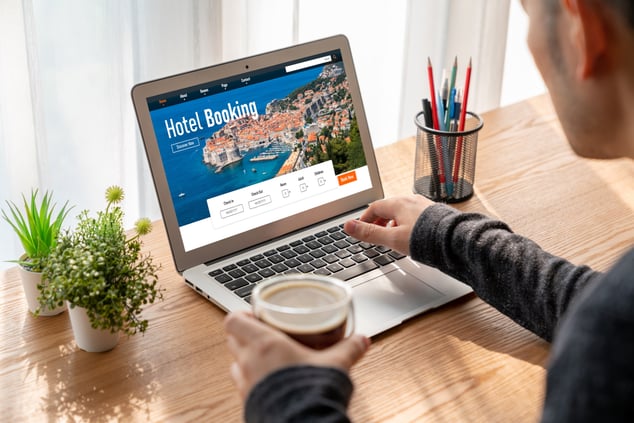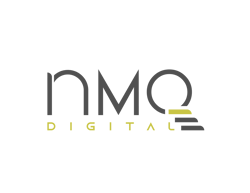Lead generation is the process by which businesses identify and attract potential customers who have shown interest in their products or services. It plays a vital role in a company's growth and success by creating a pipeline of potential customers, nurturing relationships, and ultimately converting them into paying clients.
Lead generation empowers businesses to focus their marketing efforts on individuals who are more likely to convert, resulting in higher efficiency, increased sales, and improved ROI. In today's digital age, where competition is fierce and consumer behavior is rapidly evolving, effective lead-generation strategies are essential for businesses to stay relevant and thrive in their respective industries. In this blog, we will focus on;
- The role of digital in lead generation
- The role of a website in online presence
- The role of the website in lead generation
- Website best practices for lead generation
The role of digital in lead generation
The digital landscape has revolutionized the way businesses approach lead generation and conversion. Unlike traditional methods that relied heavily on outbound marketing, the digital era has shifted the focus towards inbound strategies that prioritize providing value to potential customers. Through channels such as social media, search engines, email marketing, and content creation, businesses can now engage with their target audience in a more personalized and interactive manner.
This shift allows for the creation of targeted content that addresses specific pain points, enabling businesses to establish themselves as trusted sources of information. Additionally, advanced analytics tools provide insights into customer behavior and preferences, enabling businesses to refine their strategies continuously and tailor their approaches to meet evolving demands. The result is a dynamic and customer-centric approach to lead generation, where businesses can connect with and convert leads in ways that resonate with their unique needs and interests.
The role of a website in online presence
A website serves as the foundational cornerstone of a company's online presence, acting as a virtual headquarters where customers, prospects, and partners can gather information, engage with the brand, and initiate meaningful interactions. It offers a comprehensive and controlled platform for businesses to showcase their products, services, mission, and values, thereby establishing a credible and authentic identity in the digital realm.
In an era where online interactions shape consumer perceptions, a well-designed website not only creates a lasting first impression but also serves as a central hub for all online marketing efforts, seamlessly integrating content, social media, and lead-generation strategies to foster meaningful connections and drive business growth.
You can think of your website as a round-the-clock virtual storefront that never closes its doors. It's like having your shop accessible to customers all day, every day, no matter where they are in the world. Just as a physical store showcases your products and welcomes visitors, your website showcases your offerings, tells your brand's story, and provides a space for potential customers to explore, learn, and make informed decisions at their own convenience.
Whether it's the middle of the night or during a busy workday, your website ensures that your business is always open and ready to engage with visitors, turning curious browsers into satisfied customers whenever they're ready to take that next step.
The role of the website in lead generation
In the modern business landscape, a website serves as a pivotal central hub for all lead-generation efforts. It functions as a digital storefront, open 24/7, providing a platform for businesses to showcase their products, services, and brand identity. Through strategic design, compelling content, and user-friendly navigation, a website captivates and engages visitors, making a lasting first impression. Beyond its visual appeal, a website acts as a gateway for potential leads to explore valuable resources, informative content, and interactive tools that address their pain points and needs.

Moreover, a well-optimized website empowers businesses to seamlessly guide visitors through the lead generation process. It strategically incorporates calls-to-action (CTAs) and lead capture forms throughout its pages, encouraging visitors to take specific actions that signal their interest. These CTAs often lead to dedicated landing pages or enticing lead magnets, such as ebooks, webinars, or exclusive content, which provide additional value in exchange for contact information.
By consolidating these lead generation mechanisms within the website, businesses streamline their efforts, creating a cohesive and efficient experience for visitors and turning the website into a dynamic engine that fuels their lead generation initiatives.
Website best practices for lead generation
In today's digitally-driven landscape, an effective online presence is essential for businesses looking to thrive and expand. Lead generation lies at the heart of this endeavor, serving as the cornerstone for building a loyal customer base and driving revenue growth. To harness the full potential of your website as a lead-generation tool, it's crucial to implement best practices that capture and nurture potential leads.
In this blog, we will explore a range of strategies and tactics designed to optimize your website for lead generation, helping you convert casual visitors into enthusiastic customers and brand advocates.
1. Design and Experience
In lead generation, design and user experience stand as critical determinants of success. A thoughtfully crafted design and exceptional user experience lay the foundation for attracting and retaining potential leads.
An aesthetically pleasing and user-friendly interface not only captures attention but also establishes credibility, reinforcing the impression that the business is professional and trustworthy. Seamless navigation and intuitive layouts guide visitors effortlessly, making it easier for them to explore offerings and take desired actions, thereby increasing the chances of lead conversion.
Furthermore, an immersive user experience cultivates engagement, reducing bounce rates and prolonging interaction, which are pivotal factors in nurturing leads and guiding them along the path to becoming paying customers.

Incorporating design thinking and user-centered principles into lead generation strategies enhances the overall journey for potential customers. By addressing their needs, pain points, and preferences through an appealing design and seamless experience, businesses create an environment where leads are more inclined to engage, share information, and ultimately convert.
If you want to know what a well-designed website looks like, you can check out some fantastic examples.
2. Branding
Branding holds significant importance in lead generation as it forms the bedrock of a business's identity and perception. A strong and consistent brand image not only captures attention but also creates a lasting impression on potential leads.
A well-defined brand identity, encompassing visual elements, tone of communication, and values, establishes credibility and builds trust, crucial factors in attracting and retaining leads. When leads encounter a cohesive and recognizable brand across various touchpoints, from website design to social media presence, they are more likely to perceive the business as reputable and worthy of their consideration.
Moreover, branding plays a pivotal role in differentiation within a competitive marketplace. A distinctive brand stands out in a sea of options, making it easier for leads to remember and choose the business when they are ready to make purchasing decisions. It also fosters a sense of familiarity and connection, encouraging leads to engage and interact more deeply with the brand.
Ultimately, branding acts as a catalyst in lead generation by shaping perceptions, building trust, and creating a foundation for meaningful and lasting relationships between businesses and their potential customers.

Picture this: You're walking into a new cafe, and even before you taste the coffee, the vibe hits you. That's what branding, design, and user experience do for businesses online. It's like setting the stage for a killer first impression.
A website needs to be easy to use, like finding your way around that cafe menu without getting lost. It should be smooth and make visitors want to stick around and explore. So, just like a cafe that keeps you coming back for the atmosphere, businesses need branding, design, and user experience to create that "Wow!" moment when people land on their website.
3. Content Strategy for Lead Generation
Valuable content is like the superhero of lead generation. When businesses create content that's super useful, interesting, or solving people's problems, they're basically giving out golden tickets to their website. Valuable content doesn't just show off what a business knows; it also builds trust and shows that they care about helping people.
So, when people read a helpful blog post, watch an informative video, or download a free guide, they're not just getting answers – they're also saying, "I want more of what you've got!" That's the magic. The better the content, the more people want to stick around, learn more, and eventually become loyal customers.

However, the valuable content you are creating should be based on the pains and needs of your customers. Imagine you've got a sore back and someone hands you a heating pad – that's what businesses do with content that hits the spot.
When they create stuff that speaks directly to the problems and questions their audience has, it's like solving a puzzle – businesses figure out what's bugging their customers and then serve up content to fix it. So, by making content that targets the things people really care about, businesses build trust, keep their audience engaged, and get them coming back for more.
Find more about content marketing on our blog Content Marketing, Trends and Best Practices in 2023.
4. Opt-in Opportunities and Calls-to-Action (CTAs)
The placement and importance of opt-in opportunities, such as email subscription forms are also very crucial in the lead generation process. The forms you see on websites are like open invitations to a cool party. Businesses put them in smart spots, like after an interesting article or at the end of a helpful video.
When you share your email, you're opening a door to a world of cool updates, tips, and exclusive content. But let us remember that these forms aren't just about gathering emails; they're about building a connection. Businesses want to keep the conversation going and keep you in the loop. So, these opt-in opportunities are like little handshakes, making sure you're part of the journey they're on.
Let us also not forget about the compelling” CTAs” or "Call to Actions", which guide visitors toward taking desired actions. Businesses use CTAs to gently ask you to take steps they think you'll love.
These CTAs are like friendly tour guides that show you the most exciting parts of the website. They're designed to catch your eye, spark your curiosity, and lead you to take the desired action. When they say things like "Join our community" or "Get updates in your inbox," they're basically saying, "We'd love to hang out with you more!"
5. Landing Pages and Conversion Optimization
Landing pages are like the "Wow!" moments of the online world. They're single web pages built to grab your attention and make you say, "Tell me more!". Businesses use them in lead generation like super magnets.
These pages focus on one thing – like a super cool offer, a freebie, or a special deal – and they're all about getting you to take action. They're designed to excite, engage, and make you want to jump on board with whatever amazing thing the business is offering.

But, what should a converting landing page look like? Let's break it down.
First, you need a headline that's so tasty it makes people stop and think, "I need this in my life!". Then, there's the form design, but keep it simple, ask for just enough info without overwhelming your guests. And of course, the persuasive copy. That's like the secret sauce that makes everything irresistible and remember, keep it focused on the benefits and how it solves their problems.
Now, for the golden tip: make sure your landing page is super clear and distraction-free because you want people to focus on the main purpose. Use snazzy visuals to show what they're getting, and don't forget to sprinkle some trust elements like testimonials or badges.
And lastly, test, test, test! Just like tweaking a recipe, keep experimenting with different elements to see what makes people click.
6. Utilizing Lead Magnets
Lead magnets are the digital goodies that businesses offer. They're like the treats you get for signing up or sharing your info. Think of it like getting a free sample at the store – you're intrigued, and you're willing to share your contact details for a taste of something cool.
Lead magnets are a win-win: businesses get your info, and you get something valuable in return, like an ebook, a webinar, a helpful checklist, or testimonials. Businesses use them to show you they've got something awesome to share, and by giving your email, you're saying, "Yep, I'm interested in what you've got!"

But here's the secret sauce for promoting lead magnets: make them impossible to resist. Use pop-ups or slide-ins that appear at just the right moment, like when you're engaged with the content. Offer them as a reward for taking a quiz or subscribing to your newsletter. And don't forget to create a landing page that's so enticing, that people can't resist giving their info. By offering something truly valuable, businesses build trust and excitement, turning curious visitors into eager subscribers.
7. Building Trust and Credibility
Your website reflects your brand, which you want people to trust.
When your website looks sleek and professional, it's like wearing a suit that shows you mean business. By showing off glowing customer testimonials and success stories, you're giving potential leads a backstage pass to see how awesome your stuff really is. And when your website is easy to use, it's like welcoming guests into your home and making sure they're comfy. Topping it off with secure browsing is like locking the doors – it reassures visitors that their online journey with you is safe.
All these things combined create a sense of trust that's like the foundation of a strong friendship. So, a well-designed website isn't just about looks – it's about building a connection with your customers.
8. Analytics and Data-Driven Optimization
Analytics are like the secret sauce of lead generation – they're the magic that shows you what's really cooking. Think of it like having a crystal ball that tells you what's working and what's not.
With analytics, you're not just guessing – you're seeing real data on things like who's visiting your website, what they're clicking on, and where they're dropping off. It's like having a roadmap that guides your lead generation journey. You can see which strategies are bringing in the most leads and which ones need a little tweaking.
So, analytics take the mystery out of it all and let you fine-tune your game plan, making sure you're not just throwing darts in the dark. By keeping an eye on the numbers, you're making sure your lead-generation efforts are on track to success.

How to track the data? Well, there are many tools out there now for tracking website traffic, user behavior, and conversion rates.
Google Analytics shows you who's visiting, where they're coming from, and what they're doing on your site. Hotjar is like a detective – it records how visitors move around, where they click, and even records their mouse movements. And don't forget about tools like Crazy Egg – it's like an X-ray that shows you where people are looking and what's grabbing their attention.
These tools are like a backstage pass that helps you see what's hot and what's not, so you can tweak your strategies and turn more visitors into fans.
Read more about how data can help you tell your story on our blog How to Turn Insights Into Actionable Visuals with Data Visualization.
9. Mobile Responsiveness and Accessibility
Mobile-responsive design in lead generation is almost critical. Think about it – we're practically glued to our phones, right? So, a mobile-friendly website is like a comfy couch in our pocket. It's not just about making things look good on a small screen; it's about giving users a smooth ride, whether they're on a phone, tablet, or laptop.
Mobile-friendly websites load lightning-fast and fit perfectly, no matter the device. And when it comes to lead generation, think of mobile responsiveness as the welcome mat. You're making it super easy for users to explore, click, and engage without getting frustrated.
There is one more thing you should pay attention to though, and it is inclusivity. Your website should make everyone feel welcome.
Start by using descriptive alt text for images – it's like adding captions so everyone knows what's happening in the pictures. Make sure your fonts and colors are easy to read and keep a good balance of contrast. Think of it as making sure everyone can read the invitation clearly. Use clear headings and organize your content neatly, like labeling different sections at the party. And don't forget about keyboard navigation – it's like setting up ramps and elevators so everyone can move around easily. And finally, do not forget to test your website with screen readers.
For more information, check out our blog Web Accessibility Guidelines.
10. Integrating Social Media and SEO
Social media is like a megaphone that lets you shout out to a huge crowd – it's all about engaging and connecting with your audience, sharing valuable content, and showing off your brand's personality. It sparks conversations and builds relationships.
On the other side, SEO is like the treasure map that helps people find you when they're looking for answers. By optimizing your website for search engines, you're making sure you're right there when someone types in a question you can answer.
Together, social media and SEO create a one-two punch that not only drives traffic to your site but also turns that traffic into leads by offering them what they're looking for – valuable information and solutions to their problems.

So, when you add social sharing buttons on your website, you're giving visitors the power to easily share your awesome content – like blog posts, videos, or guides – on their social media. These buttons turn visitors into promoters, and that's a big deal in the digital world. Plus, they're like the glue that connects your website to social media platforms, creating a seamless bridge between your digital spaces.
Another thing you should do is to optimize your content for search engines. Start with keywords – these are like the secret codes people type in when searching. Sprinkle them naturally in your content, like seasoning a dish just right. Make sure your headings are clear and catchy, like chapter titles in a book. And don't forget about links – both internal links that connect to other parts of your site and external links to trusted sources. It's like showing you're well-connected.
But here's the secret sauce: create content that's so good, that people can't help but click and stay. Search engines love it when users find what they're looking for on your site. So, by nailing the keywords, structure, and links, and offering valuable content, you're not just attracting organic traffic – you're turning those visitors into potential leads who want to stick around for more.

Remember, your website isn't just a digital business card – it's a thriving hub that can drive your growth. So, let's put these insights into action. Polish your website's design, load it up with engaging content and juicy lead magnets, and keep an eye on those analytics to see what's working like a charm. Embrace mobile-friendliness, social media, and SEO as your trusty sidekicks, and make sure your website welcomes everyone with open arms.
As the digital landscape evolves, so do your strategies. So, go ahead, implement these tips, and watch your lead generation efforts soar. If you need any help, NMQ Digital is here with its SEO Services, Data & Analytics Services and Website Management Services.



